 HMS Walney
| |
| Class overview | |
|---|---|
| Operators | |
| Preceded by |
|
| Succeeded by |
|
| Built | 1927–1932 |
| In commission | 1928–1954 |
| Completed | 10 |
| Lost | 3 |
| Scrapped | 7 |
| General characteristics (Banff-class sloop) | |
| Type | Sloop |
| Displacement | 1,546 long tons (1,571 t; 1,732 short tons) |
| Length | 250 ft (76.20 m) o/a |
| Beam | 42 ft (12.80 m) |
| Draught | 16 ft (4.88 m) |
| Propulsion |
|
| Speed | 16 knots (29.6 km/h) |
| Range | 7,542 nautical miles (13,968 km) at 12 knots (22.2 km/h) |
| Complement | 97 USCG – 200 RN |
| Armament |
|
The Banff-class sloop was a group of ten warships of the Royal Navy. Built as United States Coast Guard Lake-class cutters, in 1941 these ships were loaned to the Royal Navy as antisubmarine warfare escort ships. The transfers took place at the Brooklyn Navy Yard; the sloops were manned for transport to Britain by personnel from the damaged battleship Malaya which was under repair there.
The sloops were initially part of Western Approaches command used to escort convoys such as SL convoys from Sierra Leone to Liverpool, and one, HMS Culver, was sunk by a German submarine in the Atlantic while so employed January 1942.
In 1943, the nine surviving sloops were assigned to Operation Torch—the Allied invasion of French North Africa. Two—Walney and Hartland—were destroyed in Operation Reservist in the assault to capture Oran harbor. The remaining seven escorted Mediterranean convoys in support of the North African invasion and saw varied employment in the Atlantic until assigned to the Kilindini Escort Force in late 1943 and early 1944. They stayed in the Indian Ocean for the remainder of the war escorting trade convoys in the Arabian Sea, and five served in the Bay of Bengal supporting Operation Dracula and Operation Zipper in the last months of conflict with Japan. Six were returned to the United States after the conclusion of hostilities; and one, disabled by mechanical failure, was scrapped overseas.